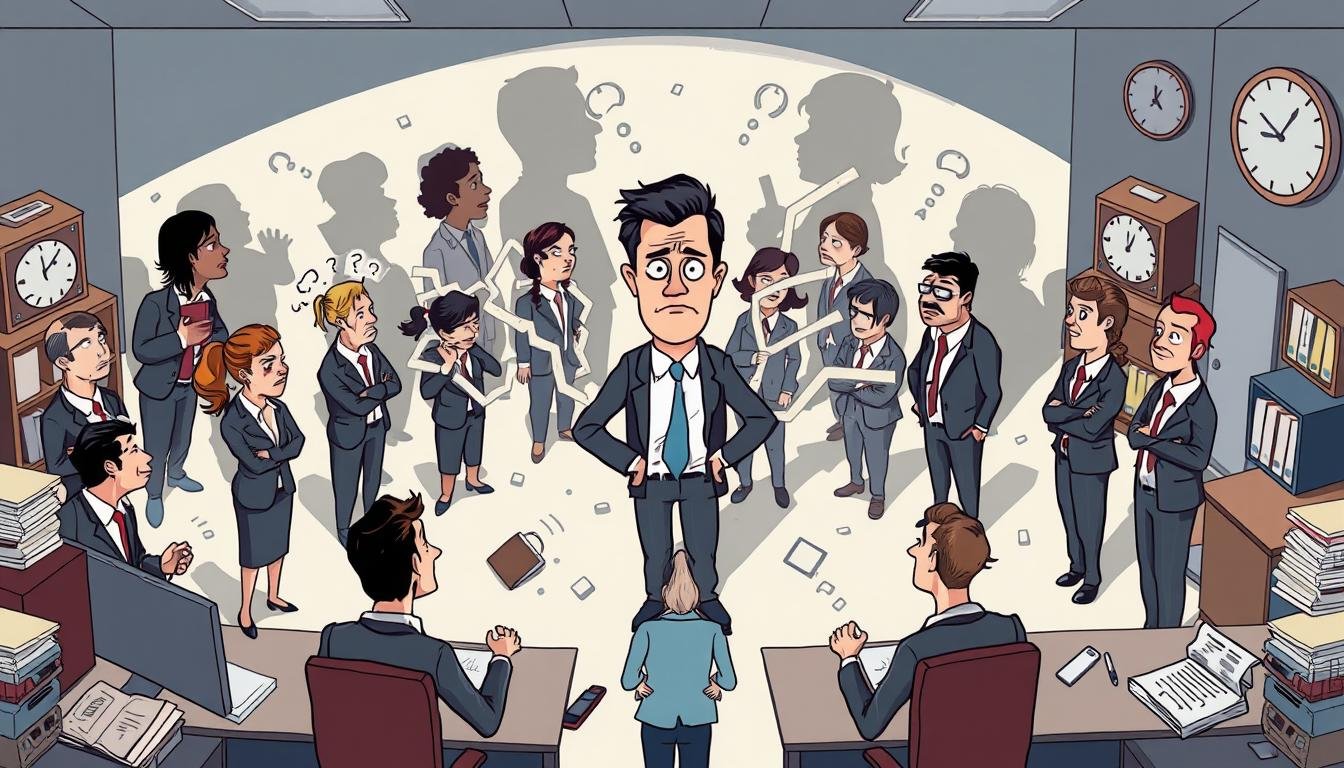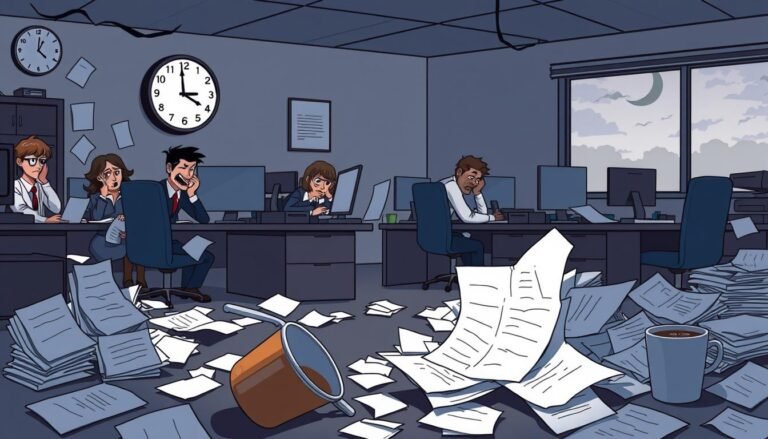Role Conflict in Organizations: A Psychological Perspective and Solutions
Ever felt pulled in different directions at work, not knowing which task to do first? This feeling, called role conflict, is a big problem in today’s workplaces. It affects how happy we are at work, how well we do our jobs, and our mental health.
Role conflict happens when workers face too many demands or aren’t sure what’s expected of them. This stress can make us less motivated and even lead to burnout. It’s important to understand role conflict to make work places better for everyone.
Studies in organizational psychology have shown how common and harmful role conflict is. For example, a study in banking found it lowers job happiness and causes tension at work. Another study found it can make workers feel emotionally drained and want to leave their jobs.
As jobs get more complex, dealing with role conflict is more important than ever. It’s not just about keeping workers happy; it’s about keeping the whole organization successful in a changing world.
Key Takeaways
- Role conflict is a major source of workplace stress
- It significantly impacts job satisfaction and productivity
- Role conflict can lead to emotional exhaustion and burnout
- Addressing role conflict is crucial for organizational success
- Understanding role conflict helps in creating harmonious work environments
Understanding Role Conflict in the Workplace
Role conflict is a big problem in today’s workplaces. It happens when workers face different expectations or demands. This can cause stress, lower job satisfaction, and reduce productivity.
Definition and Importance
Role conflict happens when workers have conflicting or overlapping roles. This can cause stress and impact health and productivity. It’s important to understand role conflict to keep a healthy work environment.
Impact on Job Satisfaction and Productivity
Role conflict greatly affects job satisfaction and productivity. A 2019 study found that it increases work stress. This stress can lead to dissatisfaction and burnout among employees.
| Impact of Role Conflict | Consequences |
|---|---|
| Increased Work Stress | Lower Job Satisfaction |
| Decreased Productivity | Higher Risk of Burnout |
| Role Confusion | Interpersonal Tension |
The Prevalence in Modern Organizations
Role conflict is common today due to complex organizations and changing work environments. New jobs, management changes, and structural shifts add to role ambiguity. The digital economy’s demands and fluid work processes make conflict more likely in complex structures.
To tackle role conflict, organizations can use clear job designs, corporate induction programs, and regular feedback. These steps help clarify roles and reduce ambiguity. This improves productivity and job satisfaction in the workplace.
Common Causes and Sources of Role Conflict
Role conflict in organizations comes from many sources. It often leads to less job satisfaction and lower productivity. A study in the banking industry showed it’s a big problem, causing tension at work. This issue is not just in banking; it’s found in many industries.
Role incompatibility is a big reason for conflict. When employees face opposite expectations, they can’t do everything well. For example, a manager might need to cut costs and improve quality at the same time. These goals can be hard to achieve together.
Having too many role expectations also adds to the tension. As companies grow, employees take on more roles. A 2008 study by the Families and Work Institute found that 49% of working dads with families face work-family conflict. This shows the struggle of handling many roles at once.
Organizational change is another big cause of role conflict. When companies change or adapt, roles can become unclear or overlap. This confusion can cause stress and uncertainty for employees.
- Ambiguity in job descriptions
- Incompatible demands from different supervisors
- Lack of clear communication
- Insufficient resources to fulfill all responsibilities
Knowing these common causes is key to solving role conflict. It helps in creating a better work environment for everyone.
Types of Role Conflict
Role conflict comes in many forms, each with its own set of challenges. It affects both work and personal life. Knowing these types helps us tackle competing demands better.
Inter-role Conflict
Inter-role conflict happens when different roles have conflicting expectations. A classic example is work-family conflict. For instance, a parent coaching their child’s sports team might find it hard to balance their duties.
Intra-role Conflict
Intra-role conflict occurs when a single role has conflicting expectations. Non-commissioned officers in the military face this often. They act as a link between officers and enlisted personnel, dealing with many expectations.
Person-role Conflict
Person-role conflict happens when personal values clash with role expectations. This is seen in gender role conflicts. For example, transgender individuals and men facing pressure to be traditionally masculine often struggle with this.
Role Overload
Role overload happens when demands are too much for one person. It’s common in situations of role strain. Single parents, for example, face this when trying to balance work, childcare, and household duties. Women in the workplace often deal with this, earning less than men while handling many roles.
| Type of Conflict | Example | Impact |
|---|---|---|
| Inter-role | Work-family conflict | Difficulty balancing professional and personal responsibilities |
| Intra-role | Non-commissioned officers in armed forces | Complexity in managing diverse expectations within a single role |
| Person-role | Gender role conflicts | Struggle to align personal identity with societal expectations |
| Role Overload | Single parents managing multiple responsibilities | Excessive stress from juggling numerous demands |
Psychological Impacts of Role Conflict
Role conflict in the workplace can have big effects on employees’ minds. It can cause mild stress or even severe emotional exhaustion. This can make people unhappy with their jobs and less productive.
Workplace stress often comes from role conflict. When employees face too many demands or expectations, they feel tense and anxious. This stress can show up as trouble focusing, being short-tempered, or feeling physically tired.
Emotional exhaustion is a serious side effect of long-term role conflict. A study by Bui et al. (2022) found that emotional exhaustion is a big part of burnout. It makes people feel constantly tired and unmotivated.
Job dissatisfaction often follows when employees can’t meet all the demands. Research by Xu (2017) and Nassar et al. (2019) showed that having too many roles can cause stress and burnout. This unhappiness can make people less productive and more likely to leave their jobs.
“One of the most crucial organizational concerns is the possibility of losing talent and potential turnover intention among talented individuals due to their high levels of emotional exhaustion.” – Wen et al. (2020)
The effects of role conflict go beyond one person, affecting the whole team. Strouse and Reed (2021) said that when people want to leave, it makes the team unstable. Newsham et al. (2022) found it also lowers productivity. These findings show why it’s key to tackle role conflict to keep a good work environment and hold onto good employees.
| Psychological Impact | Consequence | Organizational Effect |
|---|---|---|
| Workplace Stress | Anxiety, Tension | Decreased Focus |
| Emotional Exhaustion | Burnout, Low Energy | Reduced Motivation |
| Job Dissatisfaction | Decreased Engagement | Increased Turnover |
Role Conflict and Organizational Structure
The setup of a company greatly influences conflict. Let’s explore how different organizational structures impact role clarity and communication.
Hierarchical vs. Flat Organizations
In tall, pyramid-like structures, many bosses can lead to role conflicts. Flat setups, with fewer levels, might reduce some clashes but can also blur job lines. A study by Pandey and Kumar found that when two or more job expectations clash, it’s hard for workers to meet them all.
Communication Channels and Role Clarity
Clear communication is crucial for knowing who does what. When roles are unclear, it causes stress. Workers might get headaches or stomach aches from not knowing their tasks. Good communication helps prevent this role confusion.
To fix role conflicts, companies can:
- Write clear job descriptions
- Set up clear reporting lines
- Create codes of conduct
- Give regular feedback
These steps help workers understand their roles better. They also make it easier to switch between different job hats without causing problems. When people know what’s expected, they’re happier and work better together.
The Role of Emotional Intelligence in Managing Conflict
Emotional intelligence is key in handling workplace conflicts. It helps people deal with tough situations with kindness and understanding. Those with high emotional intelligence are great at solving conflicts, making teams work better and boosting productivity.
Knowing oneself is a big part of emotional intelligence. It lets people see their own feelings and how they affect others. This is very important when things get tense at work.
Being able to see things from another’s point of view is also crucial. It builds trust and lessens disagreements. By getting others’ viewpoints, people can find ways to solve problems together.
“Emotional intelligence is the ability to sense, understand, and effectively apply the power and acuity of emotions as a source of human energy, information, connection, and influence.” – Robert K. Cooper
Good communication is central to solving conflicts. Those with strong people skills can talk clearly and listen well. This helps in having useful conversations.
| Emotional Intelligence Component | Role in Conflict Resolution |
|---|---|
| Self-awareness | Recognizing emotional triggers and reactions |
| Self-regulation | Maintaining composure during heated discussions |
| Empathy | Understanding others’ feelings and perspectives |
| Social skills | Managing relationships and fostering collaboration |
By improving emotional intelligence, people can turn arguments into chances for growth and teamwork. This skill is very important in today’s fast world. Conflicts are common, but they can be handled well with the right approach.
Strategies for Individuals to Navigate Role Conflict
Dealing with role conflict requires personal skills and strategies. Let’s look at effective ways to handle these challenges at work.
Self-awareness and Reflection
Self-reflection is crucial for managing conflicts. Knowing your triggers and responses helps you tackle tough situations. Take time to understand your strengths and weaknesses.
Effective Communication Techniques
Clear communication is key to solving role conflicts. Practice active listening to grasp others’ views. Be clear about your needs and concerns.
These skills prevent misunderstandings and create a better work environment.
Setting Boundaries and Prioritization
Setting clear boundaries is essential for work-life balance. Learn to say no to tasks that don’t fit your main duties. Prioritize tasks based on importance and urgency.
This helps manage your workload and lowers stress.
| Strategy | Benefits |
|---|---|
| Self-reflection | Improved self-awareness, better conflict resolution |
| Active listening | Enhanced understanding, reduced misunderstandings |
| Setting boundaries | Improved work-life balance, reduced stress |
By using these strategies, you can manage role conflicts well. This improves your work life and helps create a more harmonious workplace.
Organizational Approaches to Mitigate Role Conflict
Organizations are key in solving role conflict. They can make work places better and happier for everyone. Let’s look at some ways companies can help.
Clear job descriptions are key. When people know what they do, they don’t get confused. Regular checks make sure jobs match the company’s goals.
Talking openly is also important. It lets teams and departments solve problems early. This builds a culture where everyone feels safe to share.
Many firms have special programs for conflict. These include training on how to talk and solve problems. Some even offer mediation to fix team disputes.
| Approach | Benefits | Implementation |
|---|---|---|
| Clear Job Descriptions | Reduces confusion and role overlap | Regular role reviews and updates |
| Open Communication | Identifies potential conflicts early | Team meetings, feedback sessions |
| Conflict Resolution Programs | Equips employees with problem-solving skills | Training workshops, mediation services |
Supporting employees is vital. Companies can offer counseling or stress management. This makes work better and happier for everyone.
The Impact of Role Conflict on Work-Life Balance
Role conflict in the workplace can really mess with an employee’s work-life balance. It can lead to stress and hurt personal wellbeing. A study of 100 employees in a Malaysian government agency found that role conflict is a big problem.
Spillover Effects on Personal Life
The bad effects of role conflict can leak into personal life. Studies show that more role conflict means less work-life balance. This can show up as:
- Less job happiness
- More stress
- Lower productivity
- More plans to leave the job
Strategies for Maintaining Balance
To fight the bad effects of role conflict, try these stress management tips:
- Make clear lines between work and personal time
- Use mindfulness and relaxation
- Get help from coworkers and bosses
- Focus on what’s important and delegate tasks
Companies can help by offering flexible work hours and valuing personal time. By tackling role conflict, businesses can make employees happier, reduce turnover, and do better overall.
| Factor | Impact on Work-Life Balance |
|---|---|
| Workload | Most dominant negative factor |
| Role Conflict | Second most significant negative factor |
| Emotional Intelligence | Positive influence on managing stress |
Role Conflict in Remote and Hybrid Work Environments
The move to remote and hybrid work has brought new challenges. Managing virtual teams now requires new strategies. With over 69% of U.S. offices closing since 2020, companies must adapt.
Leaders in virtual teams face issues like task conflicts and work-style clashes. These problems can stop projects and lead to inefficient replanning. Without face-to-face interactions, building trust and rapport is harder.
Text-based communication often leads to misunderstandings. This fuels conflicts. Companies are now using tailored strategies to tackle these issues.
Regular virtual meetings help teams understand and respect each other. Clear communication and flexible schedules prevent conflicts. Leaders can solve problems and strengthen team bonds by listening actively.
Remote work is changing the corporate world. To succeed, companies must focus on clear communication and mutual respect. This way, they can keep productivity and employee happiness high.
Source Links
- What Is Role Conflict? Definition and Examples | AllWin Conflict Resolution Training
- Decision-Making Model for Addressing Role Conflict for Psychology Trainees When Supporting Family and Community
- Role clarity, role conflict and work-related stress: Tip sheet 8
- What Is Role Conflict? A Guide for How to Overcome It
- Role Conflict: Examples & Types | Beamible
- Role conflict
- What Is Role Conflict in Sociology?
- 12 Examples of Role Conflict
- Mind Over Matter or Matter Over Mind: How Potential Role Conflict Affects the Psychological Well-Being of College Student-Athletes
- Impact of Role Conflict on Intention to Leave Job With the Moderating Role of Job Embeddedness in Banking Sector Employees
- Frontiers | The impact of role conflict on turnover intention among faculty members: A moderated mediation model of emotional exhaustion and workplace relational conflict
- Conflict Governance: Managing Role Conflict, Strain & Ambiguity
- Role ambiguity and role conflict
- Why role conflict occurs at your workplace? Discover the major reasons and how to solve the conflict.
- The Role of Emotional Intelligence in Conflict Resolution: How to Manage Conflicts Effectively in the Corporate World?
- How Emotional Intelligence Impacts Conflict Resolution
- Five Conflict-Resolution Strategies for the Workplace
- 13 Steps for Effectively Navigating Conflict
- The Art of Balance: Navigating Role Conflict & Role Ambiguity
- Betwixt and between: Role conflict, role ambiguity and role definition in project-based dual-leadership structures
- The Impact of Job Stress, Role Ambiguity and Work–Life Imbalance on Turnover Intention during COVID-19: A Case Study of Frontline Health Workers in Saudi Arabia
- How to Guard Against Remote Work Conflict — Stormboard
- How to Resolve Conflict in Remote & Hybrid Teams Effectively – Pollack Peacebuilding Systems







